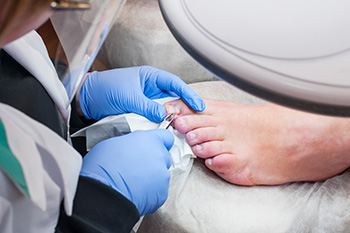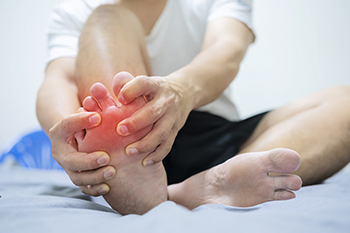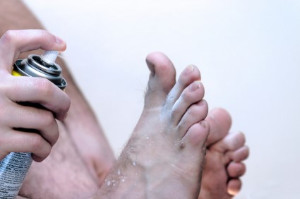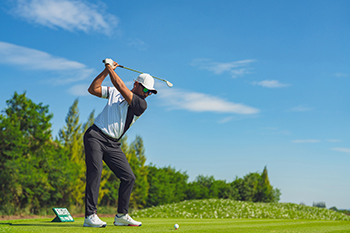
Partial nail avulsion is a surgical procedure used to treat ingrown toenails, a condition where the edge of the toenail grows into the surrounding skin, causing pain and inflammation. This procedure involves the removal of the affected portion of the toenail to alleviate discomfort and prevent recurrence. During the procedure, a podiatrist first administers a local anesthetic to numb the toe, ensuring minimal discomfort. Once the area is numb, the doctor carefully lifts the ingrown edge of the nail and removes it, allowing the surrounding tissue to heal. In some cases, a chemical agent may be applied to prevent the nail from growing back in an ingrown manner. Recovery typically involves keeping the area clean and dry, with follow-up care to monitor healing. This treatment can provide significant relief for individuals suffering from painful ingrown toenails. If you have an ingrown toenail, it is suggested that you consult a podiatrist who can determine if this type of minor foot surgery is right for you.
Foot surgery is sometimes necessary to treat a foot ailment. To learn more, contact one of our podiatrists of Jill Einhorn, DPM and James Einhorn, DPM. Our doctors will assist you with all of your foot and ankle needs.
When Is Surgery Necessary?
Foot and ankle surgery is generally reserved for cases in which less invasive, conservative procedures have failed to alleviate the problem. Some of the cases in which surgery may be necessary include:
What Types of Surgery Are There?
The type of surgery you receive will depend on the nature of the problem you have. Some of the possible surgeries include:
Benefits of Surgery
Although surgery is usually a last resort, it can provide more complete pain relief compared to non-surgical methods and may allow you to finally resume full activity.
Surgical techniques have also become increasingly sophisticated. Techniques like endoscopic surgery allow for smaller incisions and faster recovery times.
If you have any questions please feel free to contact our offices located in Brooklyn and Astoria, NY . We offer the newest diagnostic and treatment technologies for all your foot and ankle needs.

Gout is a type of inflammatory arthritis that often affects the feet and ankles, causing intense pain and swelling. It occurs when uric acid crystals build up in the joints, typically starting with a sudden, severe flare in the big toe. Symptoms include sharp, burning pain, redness, warmth, and stiffness in the affected joint. Flares can last from days to weeks, often becoming more frequent if not managed properly. Repeated gout attacks can lead to tophus formation, which are large, painful deposits of uric acid crystals in soft tissues. Bony erosion can also occur which can permanently damage the joints. Over time, this can develop into chronic arthritis, making movement difficult and painful. Treatment focuses on reducing inflammation with medications, lowering uric acid levels through lifestyle changes, with an emphasis on proper diet and hydration. If you have symptoms of gout, it is strongly suggested that you visit a podiatrist for a proper diagnosis and care.
Gout is a painful condition that can be treated. If you are seeking treatment, contact one of our podiatrists from Jill Einhorn, DPM and James Einhorn, DPM. Our doctors will treat your foot and ankle needs.
What Is Gout?
Gout is a form of arthritis that is characterized by sudden, severe attacks of pain, redness, and tenderness in the joints. The condition usually affects the joint at the base of the big toe. A gout attack can occur at any random time, such as the middle of the night while you are asleep.
Symptoms
Risk Factors
Prior to visiting your podiatrist to receive treatment for gout, there are a few things you should do beforehand. If you have gout you should write down your symptoms--including when they started and how often you experience them, important medical information you may have, and any questions you may have. Writing down these three things will help your podiatrist in assessing your specific situation so that he or she may provide the best route of treatment for you.
If you have any questions, please feel free to contact our offices located in Brooklyn and Astoria, NY . We offer the newest diagnostic and treatment technologies for all your foot care needs.

Ankle pain often directly impacts strength, balance, range of motion, and stability. When the ankle is injured or weakened, it may lead to pain, making it difficult to perform everyday movements. This pain can reduce ankle strength, as the muscles and tendons may not function optimally due to discomfort. Over time, this weakness can further affect balance, increasing the risk of falls or re-injury. Limited range of motion is another consequence, as pain restricts the joint’s ability to move freely, causing stiffness. Ankle instability can also develop when the ligaments are damaged or weakened, making the ankle prone to giving way during physical activity. If you are experiencing ankle pain, it is suggested that you schedule an appointment with a podiatrist for treatment.
Ankle pain can be caused by a number of problems and may be potentially serious. If you have ankle pain, consult with one of our podiatrists from Jill Einhorn, DPM and James Einhorn, DPM. Our doctors will assess your condition and provide you with quality foot and ankle treatment.
Ankle pain is any condition that causes pain in the ankle. Due to the fact that the ankle consists of tendons, muscles, bones, and ligaments, ankle pain can come from a number of different conditions.
Causes
The most common causes of ankle pain include:
Symptoms
Symptoms of ankle injury vary based upon the condition. Pain may include general pain and discomfort, swelling, aching, redness, bruising, burning or stabbing sensations, and/or loss of sensation.
Diagnosis
Due to the wide variety of potential causes of ankle pain, podiatrists will utilize a number of different methods to properly diagnose ankle pain. This can include asking for personal and family medical histories and of any recent injuries. Further diagnosis may include sensation tests, a physical examination, and potentially x-rays or other imaging tests.
Treatment
Just as the range of causes varies widely, so do treatments. Some more common treatments are rest, ice packs, keeping pressure off the foot, orthotics and braces, medication for inflammation and pain, and surgery.
If you have any questions, please feel free to contact our offices located in Brooklyn and Astoria, NY . We offer the newest diagnostic and treatment technologies for all your foot care needs.

Tinea pedis, commonly known as athlete's foot, is a fungal infection that affects the skin on the feet, particularly between the toes. It causes itching, redness, peeling, and sometimes a burning sensation. Unlike other foot conditions like eczema or psoriasis, which are non-infectious, tinea pedis is contagious and spreads through direct contact or contaminated surfaces like locker rooms or shared footwear. This condition thrives in warm, damp environments, making it common among athletes or those who frequently wear tight, sweaty shoes. If you have a persistent or severe case of athlete’s foot, it is suggested that you schedule an appointment with a podiatrist who can prescribe antifungal medications, both topical and oral, and provide guidance on preventing recurrence. This type of doctor may also assess if there is a secondary infection or other underlying conditions complicating the healing process.
Athlete’s Foot
Athlete’s foot is often an uncomfortable condition to experience. Thankfully, podiatrists specialize in treating athlete’s foot and offer the best treatment options. If you have any questions about athlete’s foot, consult with one of our podiatrists from Jill Einhorn, DPM and James Einhorn, DPM. Our doctors will assess your condition and provide you with quality treatment.
What Is Athlete’s Foot?
Tinea pedis, more commonly known as athlete’s foot, is a non-serious and common fungal infection of the foot. Athlete’s foot is contagious and can be contracted by touching someone who has it or infected surfaces. The most common places contaminated by it are public showers, locker rooms, and swimming pools. Once contracted, it grows on feet that are left inside moist, dark, and warm shoes and socks.
Prevention
The most effective ways to prevent athlete’s foot include:
Symptoms
Athlete’s foot initially occurs as a rash between the toes. However, if left undiagnosed, it can spread to the sides and bottom of the feet, toenails, and if touched by hand, the hands themselves. Symptoms include:
Diagnosis and Treatment
Diagnosis is quick and easy. Skin samples will be taken and either viewed under a microscope or sent to a lab for testing. Sometimes, a podiatrist can diagnose it based on simply looking at it. Once confirmed, treatment options include oral and topical antifungal medications.
If you have any questions, please feel free to contact our offices located in Brooklyn and Astoria, NY . We offer the newest diagnostic and treatment technologies for all your foot care needs.

Golf, while often seen as a low-impact sport, can still lead to various foot and ankle injuries due to repetitive motions and uneven terrain. Common injuries include ankle sprains, which occur from missteps on uneven ground, and plantar fasciitis, resulting from the constant walking and pressure on the feet. Stress fractures can develop in the metatarsal bones due to repetitive impact, especially in golfers who walk the course frequently. Tendonitis, particularly Achilles tendonitis, can arise from overuse or wearing poor footwear, leading to inflammation and pain. Golfers may also experience issues like neuromas, where nerve tissue between the toes becomes irritated, causing pain or numbness. To prevent these injuries, proper footwear with arch support should be worn. If you experience foot pain from playing golf, it is suggested that you consult a podiatrist who can provide a diagnosis and treatment, ensuring a swift recovery and return to the course.
Sports related foot and ankle injuries require proper treatment before players can go back to their regular routines. For more information, contact one of our podiatrists of Jill Einhorn, DPM and James Einhorn, DPM. Our doctors can provide the care you need to keep you pain-free and on your feet.
Sports Related Foot and Ankle Injuries
Foot and ankle injuries are a common occurrence when it comes to athletes of any sport. While many athletes dismiss the initial aches and pains, the truth is that ignoring potential foot and ankle injuries can lead to serious problems. As athletes continue to place pressure and strain the area further, a mild injury can turn into something as serious as a rupture and may lead to a permanent disability. There are many factors that contribute to sports related foot and ankle injuries, which include failure to warm up properly, not providing support or wearing bad footwear. Common injuries and conditions athletes face, including:
Sports related injuries are commonly treated using the RICE method. This includes rest, applying ice to the injured area, compression and elevating the ankle. More serious sprains and injuries may require surgery, which could include arthroscopic and reconstructive surgery. Rehabilitation and therapy may also be required in order to get any recovering athlete to become fully functional again. Any unusual aches and pains an athlete sustains must be evaluated by a licensed, reputable medical professional.
If you have any questions please feel free to contact our offices located in Brooklyn and Astoria, NY . We offer the newest diagnostic and treatment technologies for all your foot and ankle needs.